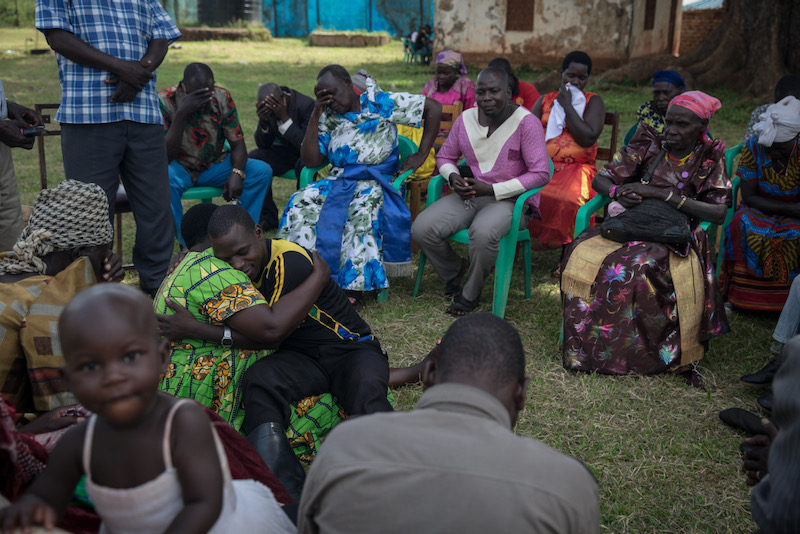I arrived at Caritas Gulu’s offices in Northern Uganda with some trepidation. My morning’s schedule was to speak to half a dozen formerly abducted persons: women who had been taken by the Lord’s Resistance Army (LRA) and had managed to escape or be rescued.
The LRA began operating in northern Uganda in the late 1980s and over a period of twenty years terrorised the population, including abducting young boys and girls to be fighters. It is estimated that more than 66,000 people were abducted, including 30,000 children, forced to fight as soldiers. The LRA soldiers would often terrorise villages where people were abducted from, leading to mass displacement and people living in camps for years.
Some of the women I spoke with had been abducted as teenagers and had been made to fight, while others had been subject to ongoing abuse, being forced to live as “wives” of the army commanders.
One young woman, Bianka, who was born in captivity because her mother was abducted at the age of 14, told me something of her ordeal:
“I will never forget the difficulties in the bush, ranging from lack of water to drink, hunger, walking days and nights without rest, carrying loads, and seeing how people were tortured and killed. Although I was less than seven years old, there was no consideration of the fact that I was younger, because my mother had other younger children to protect. Instead, I was meant to help.”
I heard many similar stories that day of what these men and women had been through, some which showed that they had managed to rebuild their lives, while others still recounted their stories, choking back the tears as they reflected on what had happened. This was November 2019, twenty years after the height of the conflict, but the ongoing impacts were still evident.
During the worst violence, most internally displaced people were given shelter, basic provision and medical treatment in churches, church schools and health centres and church-run camps, so the Catholic Church was well-known and was perceived as politically neutral and on the side of the people and trusted more than other organisations.
Archbishop Odama of Gulu was an outspoken advocate for peace. As a pastoral leader, he had several face-to-face meetings with LRA leader Joseph Kony to try and persuade him to lay down arms. He had also spearheaded the Acholi Leaders Peace Initiative to bring peace among different warring parties in the region. He was seen as being on the side of the people as he joined the “night commuters” who would walk to the centre of Gulu each night to sleep as they didn’t feel safe in their villages.
According to a new report by Cafod, The Distinctive role of the Catholic Church in development and humanitarian response, this commitment to working with those most in need, the long-term presence in communities and trust built up over years, enable the Church to have a key role in development. The report argues that governments should involve the Church earlier in any development and humanitarian work, and should support its work on peace building, tackling stigma and strengthening democracy.
In the case of northern Uganda, this meant that when formerly abducted girls, boys, young men and young women started escaping the LRA or being released directly by them, they knew and trusted the work of the Church and started seeking out the Church for help.
The closest parish to where many combatants were coming out of the bush was Pajule Parish, 106km east of Gulu town and in a remote area. Despite the ongoing instability and insecurity, Caritas Gulu decided to set up a rehabilitation centre there, to welcome people as soon as they were free, to provide safety and to work with people before they returned to their communities.
“The Caritas staff became like counsellors. Slowly the former soldiers disclosed codenames and information about their stories, they were treated for medical conditions and given counselling. Caritas staff then helped to trace their families. They kept visiting the families to help prepare them and remove the blame from being ex-soldiers. They also prepared the neighbouring families, who may have suffered.” (Paul Rubankagene, Caritas Gulu)
As well as the resilience and bravery of the women I met, what impacted deeply stayed with me the most was the additional challenges the women faced due to the stigma of having been raped and returning from the bush with children. In a culture where land is passed through the male children, there was a greater reluctance to accept women back who had male children and who would therefore need land when their boys grew up to be men. This rejection meant that many women who had been abducted as young girls, abused and who came out of the bush traumatised and with children, needed to go and start a new life in the towns away from people they knew.
It was with these women – and their wider communities – that Caritas Gulu was now focusing its work. Caritas helped many of these women with education and training, as well as support with basic needs. Caritas supported Bianka with ongoing education, enabling her to dream of a different future:
“I am now a qualified midwife…. I had a heartfelt desire to become one of the best midwives in order to save the lives of mothers and their children at birth... It is a care that I missed as a child, but I do not wish any child to go through my same condition because chances are high that without the service of a nurse or a midwife, anyone can die. This now is my prayer, that more doors open for the rest of the children who are vulnerable.”
Caritas is also committed to working with communities towards the long-term aims of reintegration, which requires changing behaviour of communities to tackle issues of stigma and rejection and to welcome back formerly abducted people. The Local staff spend a lot of time tracing families and visiting communities to help people understand what returnees have gone through and to focus on acceptance and reintegration. They provide communities with seeds and tools so that the whole community benefits from accepting people back.
There are many cases where this has been successful, in particularly with men, who could return to their communities and continue to farm and live with their families. But there is an ongoing challenge with women being able to return and it is here that I’ve seen the Church accompanying them every step of the way.
Graham Gordon is Head of Policy at CAFOD, and author of the report: The Distinctive role of the Catholic Church in humanitarian and development response.



 Loading ...
Loading ...
What do you think?
You can post as a subscriber user ...
User comments (0)